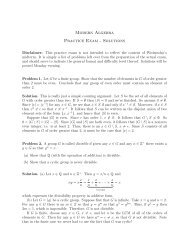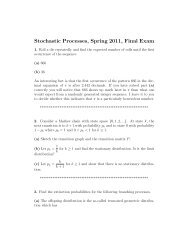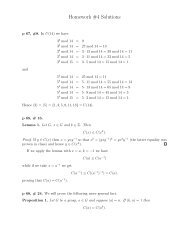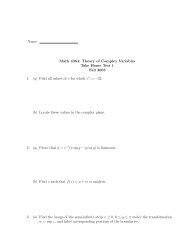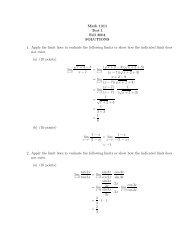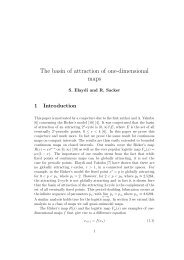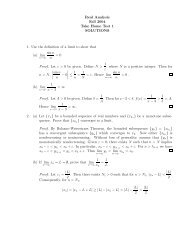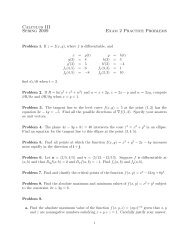Introduction to Sturm-Liouville Theory - Trinity University
Introduction to Sturm-Liouville Theory - Trinity University
Introduction to Sturm-Liouville Theory - Trinity University
Create successful ePaper yourself
Turn your PDF publications into a flip-book with our unique Google optimized e-Paper software.
Orthogonality <strong>Sturm</strong>-<strong>Liouville</strong> problems Eigenvalues and eigenfunctions<strong>Introduction</strong> <strong>to</strong> <strong>Sturm</strong>-<strong>Liouville</strong> <strong>Theory</strong>Ryan C. Daileda<strong>Trinity</strong> <strong>University</strong>Partial Differential EquationsApril 10, 2012Daileda<strong>Sturm</strong>-<strong>Liouville</strong> <strong>Theory</strong>
Orthogonality <strong>Sturm</strong>-<strong>Liouville</strong> problems Eigenvalues and eigenfunctionsInner products with weight functionsSuppose that w(x) is a nonnegative function on [a,b]. If f (x) andg(x) are real-valued functions on [a,b] we define their innerproduct on [a,b] with respect <strong>to</strong> the weight w <strong>to</strong> be〈f ,g〉 =∫ baf (x)g(x)w(x)dx.We say f and g are orthogonal on [a,b] with respect <strong>to</strong> theweight w if〈f ,g〉 = 0.Remarks:The inner product and orthogonality depend on the choice ofa, b and w.When w(x) ≡ 1, these definitions reduce <strong>to</strong> the “ordinary”ones.Daileda<strong>Sturm</strong>-<strong>Liouville</strong> <strong>Theory</strong>
Orthogonality <strong>Sturm</strong>-<strong>Liouville</strong> problems Eigenvalues and eigenfunctionsExamples1 The functions f n (x) = sin(nx) (n = 1,2,...) are pairwiseorthogonal on [0,π] relative <strong>to</strong> the weight function w(x) ≡ 1.2 Let J m be the Bessel function of the first kind of order m, andlet α mn denote its nth positive zero. Then the functionsf n (x) = J m (α mn x/a) are pairwise orthogonal on [0,a] withrespect <strong>to</strong> the weight function w(x) = x.3 The functionsf 0 (x) = 1, f 1 (x) = 2x, f 2 (x) = 4x 2 − 1, f 3 (x) = 8x 3 − 4x,f 4 (x) = 16x 4 − 12x 2 + 1,f 5 (x) = 32x 5 − 32x 3 + 6xare pairwise orthogonal on [−1,1] relative <strong>to</strong> the weightfunction w(x) = √ 1 − x 2 . They are examples of Chebyshevpolynomials of the second kind.Daileda<strong>Sturm</strong>-<strong>Liouville</strong> <strong>Theory</strong>
Orthogonality <strong>Sturm</strong>-<strong>Liouville</strong> problems Eigenvalues and eigenfunctionsSeries expansionsWe have frequently seen the need <strong>to</strong> express a given function as alinear combination of an orthogonal set of functions. Ourfundamental result generalizes <strong>to</strong> weighted inner products.TheoremSuppose that {f 1 ,f 2 ,f 3 ,...} is an orthogonal set of functions on[a,b] with respect <strong>to</strong> the weight function w. If f is a function on[a,b] and∞∑f (x) = a n f n (x),n=1then the coefficients a n are given bya n = 〈f ,f ∫ bn〉〈f n ,f n 〉 = a f (x)f n(x)w(x)dx∫ b.n (x)w(x)dxa f 2Daileda<strong>Sturm</strong>-<strong>Liouville</strong> <strong>Theory</strong>
Orthogonality <strong>Sturm</strong>-<strong>Liouville</strong> problems Eigenvalues and eigenfunctionsRemarksThe series expansion above is called a generalized Fourierseries for f , and a n are the generalized Fourier coefficients.It is natural <strong>to</strong> ask:Where do orthogonal sets of functions come from?To what extent is an orthogonal set complete, i.e. whichfunctions f have generalized Fourier series expansions?In the context of PDEs, these questions are answered by<strong>Sturm</strong>-<strong>Liouville</strong> <strong>Theory</strong>.Daileda<strong>Sturm</strong>-<strong>Liouville</strong> <strong>Theory</strong>
Orthogonality <strong>Sturm</strong>-<strong>Liouville</strong> problems Eigenvalues and eigenfunctions<strong>Sturm</strong>-<strong>Liouville</strong> equationsA <strong>Sturm</strong>-<strong>Liouville</strong> equation is a second order linear differentialequation that can be written in the form(p(x)y ′ ) ′ + (q(x) + λr(x))y = 0.Such an equation is said <strong>to</strong> be in <strong>Sturm</strong>-<strong>Liouville</strong> form.ExampleHere p,q and r are specific functions, and λ is a parameter.Because λ is a parameter, it is frequently replaced by othervariables or expressions.Many “familiar” ODEs that occur during separation ofvariables can be put in <strong>Sturm</strong>-<strong>Liouville</strong> form.Show that y ′′ + λy = 0 is a <strong>Sturm</strong>-<strong>Liouville</strong> equation.We simply take p(x) = r(x) = 1 and q(x) = 0.Daileda<strong>Sturm</strong>-<strong>Liouville</strong> <strong>Theory</strong>
Orthogonality <strong>Sturm</strong>-<strong>Liouville</strong> problems Eigenvalues and eigenfunctionsExamplePut the parametric Bessel equationin <strong>Sturm</strong>-<strong>Liouville</strong> form.First we divide by x <strong>to</strong> getx 2 y ′′ + xy ′ + (λ 2 x 2 − m 2 )y = 0xy ′′ + y ′ +} {{ }(xy ′ ) ′(λ 2 x − m2This is in <strong>Sturm</strong>-<strong>Liouville</strong> form withx)y = 0.p(x) = x,q(x) = − m2, r(x) = x,xprovided we write the parameter as λ 2 .Daileda<strong>Sturm</strong>-<strong>Liouville</strong> <strong>Theory</strong>
Orthogonality <strong>Sturm</strong>-<strong>Liouville</strong> problems Eigenvalues and eigenfunctionsExamplePut Legendre’s differential equationy ′′ −in <strong>Sturm</strong>-<strong>Liouville</strong> form.First we multiply by 1 − x 2 <strong>to</strong> get2x1 − x 2y ′ + µ1 − x 2y = 0(1 − x 2 )y ′′ − 2xy ′ +µy = 0.} {{ }((1−x 2 )y ′ ) ′This is in <strong>Sturm</strong>-<strong>Liouville</strong> form withp(x) = 1 − x 2 , q(x) = 0, r(x) = 1,provided we write the parameter as µ.Daileda<strong>Sturm</strong>-<strong>Liouville</strong> <strong>Theory</strong>
Orthogonality <strong>Sturm</strong>-<strong>Liouville</strong> problems Eigenvalues and eigenfunctionsExamplePut Chebyshev’s differential equationin <strong>Sturm</strong>-<strong>Liouville</strong> form.(1 − x 2 )y ′′ − xy ′ + n 2 y = 0First we divide by √ 1 − x 2 <strong>to</strong> get√1 − x 2 y ′′ x− √ y ′1 − x 2} {{ }( √ 1−x 2 y ′ ) ′ + n2This is in <strong>Sturm</strong>-<strong>Liouville</strong> form withp(x) =√1 − x 2 y = 0.√1 − x 2 , q(x) = 0, r(x) =provided we write the parameter as n 2 .Daileda<strong>Sturm</strong>-<strong>Liouville</strong> <strong>Theory</strong>1√1 − x 2 ,
Orthogonality <strong>Sturm</strong>-<strong>Liouville</strong> problems Eigenvalues and eigenfunctions<strong>Sturm</strong>-<strong>Liouville</strong> problemsA <strong>Sturm</strong>-<strong>Liouville</strong> problem consists ofA <strong>Sturm</strong>-<strong>Liouville</strong> equation on an interval:<strong>to</strong>gether with(p(x)y ′ ) ′ + (q(x) + λr(x))y = 0, a < x < b, (1)Boundary conditions, i.e. specified behavior of y at x = aand x = b.We will assume that p, p ′ , q and r are continuous and p > 0 on(at least) the open interval a < x < b.According <strong>to</strong> the general theory of second order linear ODEs, thisguarantees that solutions <strong>to</strong> (1) exist.Daileda<strong>Sturm</strong>-<strong>Liouville</strong> <strong>Theory</strong>
Orthogonality <strong>Sturm</strong>-<strong>Liouville</strong> problems Eigenvalues and eigenfunctionsRegularity conditionsA regular <strong>Sturm</strong>-<strong>Liouville</strong> problem has the formwhere:(p(x)y ′ ) ′ + (q(x) + λr(x))y = 0, a < x < b,c 1 y(a) + c 2 y ′ (a) = 0, (2)d 1 y(b) + d 2 y ′ (b) = 0, (3)(c 1 ,c 2 ) ≠ (0,0) and (d 1 ,d 2 ) ≠ (0,0);p, p ′ , q and r are continuous on [a,b];p and r are positive on [a,b].The boundary conditions (2) and (3) are called separatedboundary conditions.Daileda<strong>Sturm</strong>-<strong>Liouville</strong> <strong>Theory</strong>
Orthogonality <strong>Sturm</strong>-<strong>Liouville</strong> problems Eigenvalues and eigenfunctionsExampleThe boundary value problemy ′′ + λy = 0, 0 < x < L,y(0) = y(L) = 0,is a regular <strong>Sturm</strong>-<strong>Liouville</strong> problem (recall that p(x) = r(x) = 1and q(x) = 0).ExampleThe boundary value problem((x 2 + 1)y ′ ) ′ + (x + λ)y = 0, −1 < x < 1,y(−1) = y ′ (1) = 0,is a regular <strong>Sturm</strong>-<strong>Liouville</strong> problem (here p(x) = x 2 + 1, q(x) = xand r(x) = 1).Daileda<strong>Sturm</strong>-<strong>Liouville</strong> <strong>Theory</strong>
Orthogonality <strong>Sturm</strong>-<strong>Liouville</strong> problems Eigenvalues and eigenfunctionsExampleThe boundary value problemx 2 y ′′ + xy ′ + (λ 2 x 2 − m 2 )y = 0, 0 < x < a,y(a) = 0,is not a regular <strong>Sturm</strong>-<strong>Liouville</strong> problem.Why not? Recall that when put in <strong>Sturm</strong>-<strong>Liouville</strong> form we hadp(x) = r(x) = x and q(x) = −m 2 /x. There are several problems:p and r are not positive when x = 0.q is not continuous when x = 0.The boundary condition at x = 0 is missing.This is an example of a singular <strong>Sturm</strong>-<strong>Liouville</strong> problem.Daileda<strong>Sturm</strong>-<strong>Liouville</strong> <strong>Theory</strong>
Orthogonality <strong>Sturm</strong>-<strong>Liouville</strong> problems Eigenvalues and eigenfunctionsEigenvalues and eigenfunctionsA nonzero function y that solves the <strong>Sturm</strong>-<strong>Liouville</strong> problem(p(x)y ′ ) ′ + (q(x) + λr(x))y = 0, a < x < b,(plus boundary conditions),is called an eigenfunction, and the corresponding value of λ iscalled its eigenvalue.The eigenvalues of a <strong>Sturm</strong>-<strong>Liouville</strong> problem are the valuesof λ for which nonzero solutions exist.We can talk about eigenvalues and eigenfunctions for regularor singular problems.Daileda<strong>Sturm</strong>-<strong>Liouville</strong> <strong>Theory</strong>
Orthogonality <strong>Sturm</strong>-<strong>Liouville</strong> problems Eigenvalues and eigenfunctionsExampleFind the eigenvalues of the regular <strong>Sturm</strong>-<strong>Liouville</strong> problemy ′′ + λy = 0, 0 < x < L,y(0) = y(L) = 0,This problem first arose when separated variables in the 1-D waveequation. We already know that nonzero solutions occur only whenandfor n = 1,2,3,...λ = λ n = n2 π 2L 2y = y n = sin nπxL(eigenvalues)(eigenfunctions)Daileda<strong>Sturm</strong>-<strong>Liouville</strong> <strong>Theory</strong>
Orthogonality <strong>Sturm</strong>-<strong>Liouville</strong> problems Eigenvalues and eigenfunctionsExampleFind the eigenvalues of the regular <strong>Sturm</strong>-<strong>Liouville</strong> problemy ′′ + λy = 0, 0 < x < L,y(0) = 0, y(L) + y ′ (L) = 0,This problem arose when we separated variables in the 1-D heatequation with Robin conditions. We already know that nonzerosolutions occur only whenλ = λ n = µ 2 n ,where µ n is the nth positive solution <strong>to</strong>tanµL = −µ,andfor n = 1,2,3,...y = y n = sin(µ n x)Daileda<strong>Sturm</strong>-<strong>Liouville</strong> <strong>Theory</strong>
Orthogonality <strong>Sturm</strong>-<strong>Liouville</strong> problems Eigenvalues and eigenfunctionsExampleIf m ≥ 0, find the eigenvalues of the singular <strong>Sturm</strong>-<strong>Liouville</strong>problemx 2 y ′′ + xy ′ + (λ 2 x 2 − m 2 )y = 0, 0 < x < a,y(0) is finite, y(a) = 0.This problem arose when we separated variables in the vibratingcircular membrane problem. We know that nonzero solutions occuronly whenλ = λ n = α mna ,where α mn is the nth positive zero of the Bessel function J m , andy = y n = J m (λ n x)for n = 1,2,3,... (technically, the eigenvalues are λ 2 n = α 2 mn/a 2 .)Daileda<strong>Sturm</strong>-<strong>Liouville</strong> <strong>Theory</strong>
Orthogonality <strong>Sturm</strong>-<strong>Liouville</strong> problems Eigenvalues and eigenfunctionsThe previous examples demonstrate the following generalproperties of a regular <strong>Sturm</strong>-<strong>Liouville</strong> problem(p(x)y ′ ) ′ + (q(x) + λr(x))y = 0, a < x < b,c 1 y(a) + c 2 y ′ (a) = 0, d 1 y(b) + d 2 y ′ (b) = 0.TheoremThe eigenvalues form an increasing sequence of real numberswithλ 1 < λ 2 < λ 3 < · · ·lim λ n = ∞.n→∞Moreover, the eigenfunction y n corresponding <strong>to</strong> λ n is unique (up<strong>to</strong> a scalar multiple), and has exactly n − 1 zeros in the intervala < x < b.Daileda<strong>Sturm</strong>-<strong>Liouville</strong> <strong>Theory</strong>
Orthogonality <strong>Sturm</strong>-<strong>Liouville</strong> problems Eigenvalues and eigenfunctionsAnother general property is the following.TheoremSuppose that y j and y k are eigenfunctions corresponding <strong>to</strong>distinct eigenvalues λ j and λ k . Then y j and y k are orthogonal on[a,b] with respect <strong>to</strong> the weight function w(x) = r(x). That is〈y j ,y k 〉 =∫ bay j (x)y k (x)r(x)dx = 0.This theorem actually holds for certain non-regular<strong>Sturm</strong>-<strong>Liouville</strong> problems, such as those involving Bessel’sequation.Applying this result in the examples above we immediatelyrecover familiar orthogonality statements.This result explains why orthogonality figures so prominentlyin all of our work.Daileda<strong>Sturm</strong>-<strong>Liouville</strong> <strong>Theory</strong>
Orthogonality <strong>Sturm</strong>-<strong>Liouville</strong> problems Eigenvalues and eigenfunctionsExamplesExampleWrite down the conclusion of the orthogonality theorem fory ′′ + λy = 0, 0 < x < L,y(0) = y(L) = 0.Since the eigenfunctions of this regular <strong>Sturm</strong>-<strong>Liouville</strong> problem arey n = sin(nπx/L), and since r(x) = 1, we immediately deduce thatfor m ≠ n.∫ L0sin( mπx) ( nπx)sin dx = 0L LDaileda<strong>Sturm</strong>-<strong>Liouville</strong> <strong>Theory</strong>
Orthogonality <strong>Sturm</strong>-<strong>Liouville</strong> problems Eigenvalues and eigenfunctionsExampleIf m ≥ 0, write down the conclusion of the orthogonality theoremforx 2 y ′′ + xy ′ + (λ 2 x 2 − m 2 )y = 0, 0 < x < a,y(0) is finite, y(a) = 0.Since the eigenfunctions of this regular <strong>Sturm</strong>-<strong>Liouville</strong> problem arey n = J m (α mn x/a), and since r(x) = x, we immediately deducethat ∫ a ( αmk) (J ma x αml)J ma x x dx = 0for k ≠ l.0Daileda<strong>Sturm</strong>-<strong>Liouville</strong> <strong>Theory</strong>



